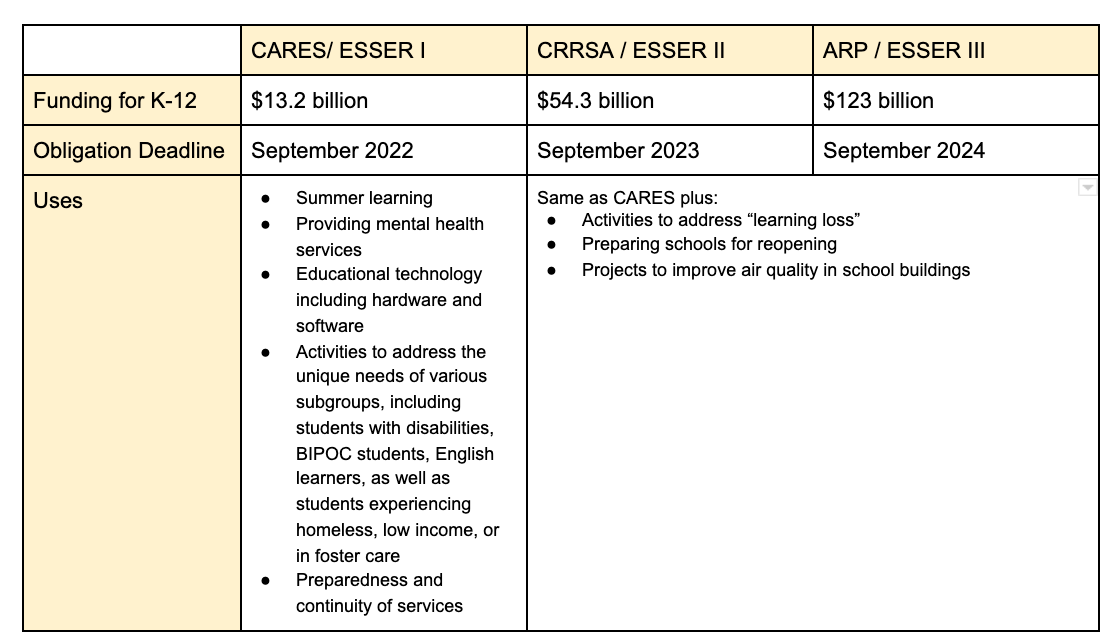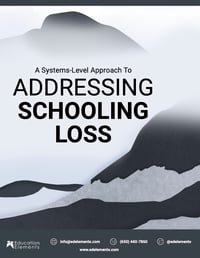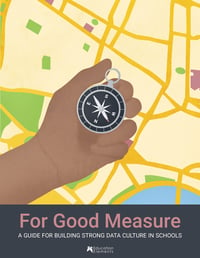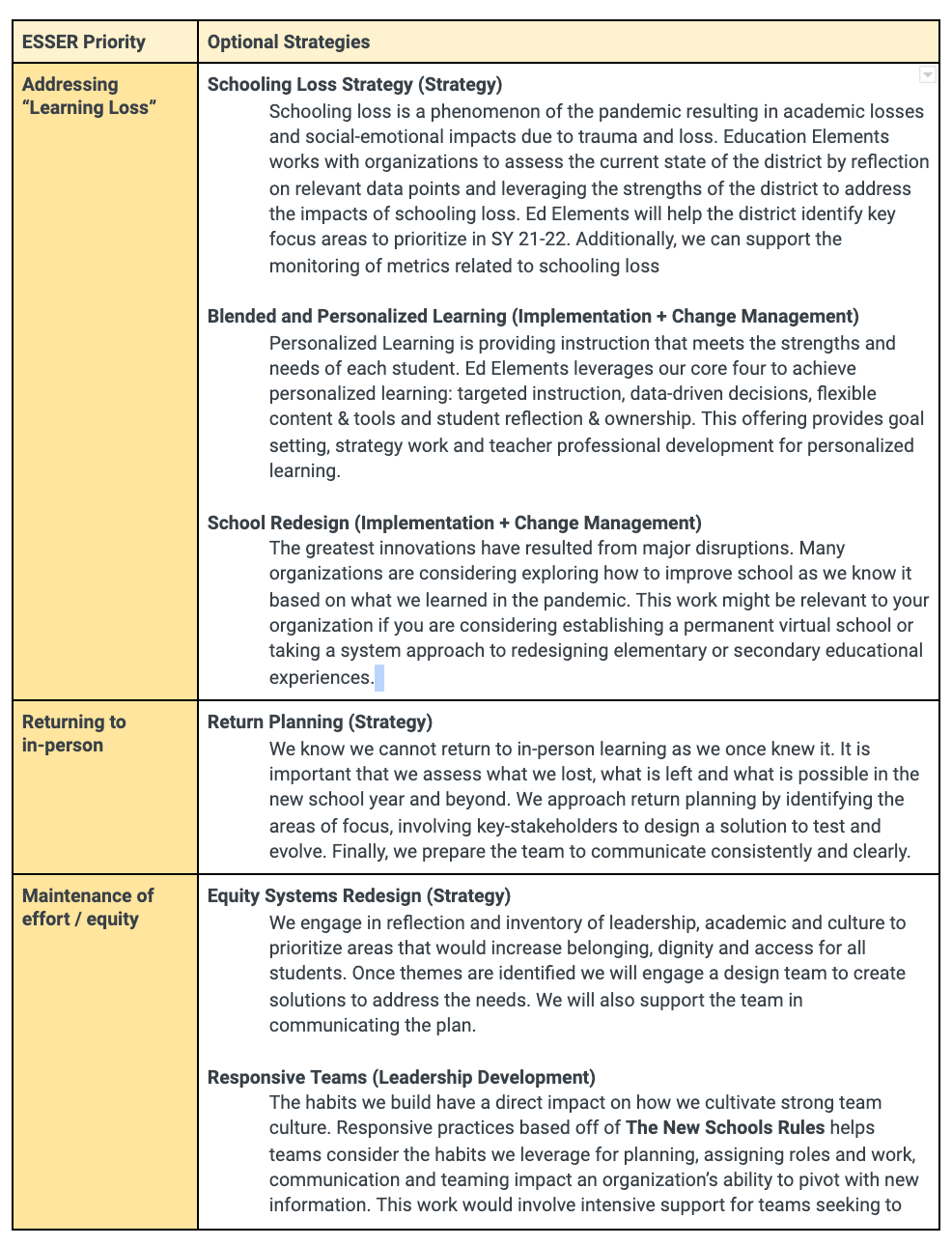The federal government recently passed three funding packages intended to support schools and districts nationally as they contend with the impacts from the pandemic. Taken together these three acts provide resources for schools to reopen safely, improve preparedness, and begin to support the varied needs of children.
ESSER stands for the Elementary and Secondary School Emergency Relief fund. This significant funding was included in the three recent funding packages signed into law in 2020 and 2021: the CARES Act, CRRSA, and the American Rescue Plan.
The differences are noteworthy. Between ESSER I and ESSER III, the funding increased by 10x, and the allowable uses expanded to include “learning loss” and preparing schools for reopening. In addition the deadlines to obligate the funding varies.

 Addressing schooling loss is a complex, new, and unknown reality that all districts must navigate. In our new guide, we approach planning to address schooling loss (distinct from learning loss) in three parts. We begin by looking at the big picture and progressively get more tactical.
Addressing schooling loss is a complex, new, and unknown reality that all districts must navigate. In our new guide, we approach planning to address schooling loss (distinct from learning loss) in three parts. We begin by looking at the big picture and progressively get more tactical.

Website: Education Stabilization Funds - US Department of Education
Fact Sheet: ESSER I / ESSER II
Fact Sheet: ARP ESSER / ESSER III
In order to access the new funding, school districts must apply directly to their states. While each state process and timeline is different, states will require districts to develop and submit plans that reflect the needs of the district, include community input, and align with district priorities. Here are some common requirements - before responding be sure to see your state specific requirements.
Again this varies by state, but most states will require plans for ESSER III funding in June 2021. States are required to get the funding to districts quickly, which in turn requires the grant application, and the turnaround time to be short.
Involving stakeholders in your planning is essential. In fact, the process of planning is equally or more important than the plan itself. Working with your stakeholders intentionally, enables you to glean your community’s priorities, pain points and questions which may have evolved during the course of the pandemic. And when done well, it can ensure an authentic representation of multiple viewpoints, provide inputs that help to prioritize diversity of thought and perspective, and lay the foundation for stakeholder investment in the work. Your first encounters with stakeholders are critical as they will set the precedent for how they will engage throughout the planning and implementation.
We recommend the following steps:
Step 1: Articulate Your Why
Clearly define the information you need from your stakeholders and the reason you need it. What will you do with the information you gather? Clarity on this before you get started will ensure you are using time and resources efficiently and will encourage participation from your stakeholders.
Step 2: Identify Your Stakeholders
Consider who will be impacted by the change you are considering: students, teachers, families, alumni, community members, staff, campus leaders, and district leaders are typical stakeholder groups, but, depending on your initiative, you may have different or more stakeholders. Be sure to consider those who you may not see or hear from often, and include them in the process.
Step 3: Plot Your Stakeholders on an Engagement Matrix
Utilizing a matrix to place your stakeholders according to interest and influence will help you determine the best approach to involve each group.
Step 4: Explore Tactics Aligned with Your Needs
Reviewing options for the different ways you can engage different groups will ensure that the time you spend developing your tools and conducting your research will have the most impact. The variety of methods for engaging stakeholders can include: focus groups, surveys, town halls, in depth interviews, empathy interviews, shadowing, and community walks. For more ideas and a breakdown of these methods read our Equitable Inclusion Guide.
Guide: Stakeholder Engagement Guide
Guide: Equitable Inclusion Guide
Guide: Guide to Conducting Focus Groups
Blog: 4 Steps to Effective Engagement During Planning
Article: Perspectives on How Schools Should Spend COVID Relief Aid
 Today, many school districts struggle with DRIP syndrome: they are Data Rich and Information Poor because their ability to organize, process, and understand data is limited. With our new guide, we provide strategies for district and school leaders to better understand their existing data culture and identify the ways in which it needs to be improved.
Today, many school districts struggle with DRIP syndrome: they are Data Rich and Information Poor because their ability to organize, process, and understand data is limited. With our new guide, we provide strategies for district and school leaders to better understand their existing data culture and identify the ways in which it needs to be improved.

Even before the pandemic, many school districts had significant needs. Post-pandemic these needs are even greater. So despite the additional funding, many school districts will need to prioritize their efforts and time. How you prioritize will not only help you to target the most important needs, but the prioritization process will help you to reinforce your values, and begin to build support behind your plan.
At Education Elements, we use a prioritization matrix with our districts. After making an informed list of all of the strategies, we draw a two-by-two matrix. We often ascribe the vertical axis to represent your definition of impact and the horizontal axis to represent the ease of implementation. This allows you to identify projects that are impactful while not being overly complex.
An important note - while prioritizing your strategies it is critical to consider projects that support “edge cases” and not solely those focused on the entire community. Past experience shows us that designing for edge cases can encourage innovative thinking that is beneficial for all. Think about the ADA-compliant bathroom stall designed for someone using mobility equipment; it is also useful for someone traveling with a service animal or a parent with a young child needing the changing station. Edge cases allow us to reflect on where success in one extreme situation might breed success in another.
Examples of this include cases like the following:
Blog: How a prioritization matrix can help your school district
Blog: Post pandemic possibilities for schools
Guide: Guide: Strategic Planning Prioritization Guide
Toolkit: Workbook to Guide Systems in Allocating Federal COVID Relief Aid
We see three key priorities for ESSER II and ESSER III.
While the term “learning loss” has been widely rejected by many educators, it is the official language of the law in ESSER II and ESSER III; and as such, we can expect states and districts to be required to address it, and the academic needs of their students, explicitly.
Many districts are reaching out to Education Elements to ask for our help with these priorities - in part because our core competencies are around systems-level strategy, school design and implementation, and leadership development.
Take a look at how we are helping school districts address their ESSER priorities:

Although the Department of Education released a sample plan template to states recently many districts are just now developing their plans. That is to say, districts are planning - and most haven’t made their plans public (as of May 2021).